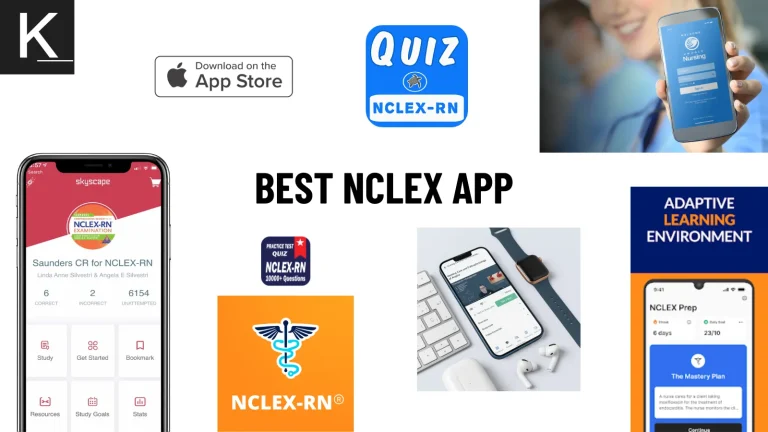How to answer NCLEX questions? The NCLEX test is one of the pivotal challenges on your path to becoming a registered nurse. Unlike most tests you’ve encountered in your academic studies, this one assesses your ability to apply your knowledge in practical nursing situations. So NCLEX questions necessitate meticulous reading, critical thinking, assertiveness, and a tactical approach to ensure accuracy in your responses.
How To Answer NCLEX Questions?
Here is a detailed guide to help you understand every single aspect of NCLEX questions and then apply your nursing knowledge effectively.
Step 1: Taking Practice Tests
The main purpose of a practice test isn’t to confirm that you already have the knowledge to pass the exam. The point of practice tests is to learn how to take the NCLEX. Wrong answers can show you your knowledge gaps. You will know why the correct answer is right and why the incorrect options are wrong.

Step 2: Know the Question Format
Even with substantial knowledge, you can make mistakes by misinterpreting the exam’s questions. To sidestep this common error, you need to dissect the NCLEX questions and grasp their format. This enables you to grasp precisely what is being asked before letting your knowledge come out to play.
Multiple-Choice Questions
Multiple-choice questions include one question followed by several answers. Here are three types of multiple-choice questions you may encounter:
- Positive questions require you to choose the correct answer from the available options. These questions are relatively straightforward and typically include words like “appropriate,” “correct,” “true,” “indication,” etc.
- Negative questions are trickier since they require you to find the false answer among true options. Look for words that signal a negative question, including “negate,” “refute,” “least,” “not/never,” “contraindicated,” and “avoid.”
- Priority questions require you to select the most correct or first action from a list of correct answers. They may include words like “most appropriate,” “first,” “priority,” “best,” “primary,” and “initial.”
Alternate-Format Questions
Alternate-format questions can come in many different formats, such as:
- Chart questions provide you with a chart. You might be asked to interpret this information to answer alternate-format or multiple-choice questions.
- Audio questions have you listen to audio clips (like heart sounds or respiratory sounds) and then answer the question.
- Graphic questions provide images as possible answers and you’ll need to choose the correct one.
- Hot spot questions present you with an image, such as a scan or body part. You are asked to click on a specific area indicated by the question
- Blank questions require you to type your answer into a blank field.
- Ordered response questions have you dragged and dropped answers into the right sequence. Sometimes, you have to rank them by priority.
- Multiple-response questions ask you to choose all answers that apply from a list of options.
- Bowtie questions might ask you to link cause and effect or to select interventions and outcomes related to a central problem. They require a comprehensive approach to patient care, considering both preventive measures and interventions for specific conditions.
Step 3: Pay Attention to Key Information
Once you understand the format of the question, you need to focus on identifying keywords that clarify what each question requires. Looking for something like:
- Client information: such as age, gender, and weight.
- Symptoms
- Pertinent clinical information, such as diagnoses, post-operative status, etc.
- Vital signs & laboratory findings.
- Prescribed medications along with their dosages.
- Any numerical data within the question.

Step 4: Understanding the Client’s Situation
By now, you should be familiar with the question’s format and have gathered all the necessary data to address it. It’s time to delve into the client’s overall situation.
Say the question Your Own Way
This allows you to grasp the question’s essence. It not only confirms your understanding of the question but may also reveal important insights into the client’s situation, aiding you in providing the correct response.
Adopt a Comprehensive Perspective
When analyzing an NCLEX question, every piece of information counts. Avoid making assumptions about the patient’s situation that aren’t clearly stated and ignoring any details provided. Pay attention to these cues as you piece together the patient’s context and scenario:
- Age
- Symptoms
- Medical history
- Social & cultural background
- Emotional well-being
- Any other aspect that affects their care
Step 5: Eliminate the Wrong Choices
As for multiple-choice questions, there’s usually one right answer accompanied by three distractors. Use these strategies to identify the incorrect options:
Watch for Duplicates
If you notice three options are similar and one stands out as different, the unique one is often the right choice.
Be Skeptical of Absolutes
Certainties are rare in the realms of nursing, life, and health. Hence, answers that use absolute terms such as “will,” “never,” “always,” “all,” or “none” can often be dismissed.
Ignore Irrelevant Options
Stay alert for misleading options. An answer might introduce a concept with nothing to do with the main question. These are usually wrong.
Shortcuts
Unless the question suggests otherwise, base your answers on complete nursing practices, assuming perfect conditions, including enough staff, time, and resources.
Elimination Process
When you find yourself puzzled by a question, using the elimination process can help you make a more informed guess. First, dismiss any clearly incorrect options, then make your selection rather than choosing randomly.
Step 6: Critical Thinking
Your ability to think critically and use clinical judgment is essential for understanding scenarios and applying your knowledge before making decisions. To tackle NCLEX questions effectively, you must break them down and prioritize the information, guiding you to the best answers. Let’s take a look at some things that will aid in passing the test:
Read Questions Carefully
One common mistake on the NCLEX is misinterpreting the question. Focus on the wording and the question’s purpose before reviewing the answer choices. It’s beneficial to read each question at least twice, paying attention to the phrasing of both the question and the answers.

Identify Patterns
By noticing patterns in questions and even answers, you can form mental links and choose the correct answers. Look for patterns, such as answer options, that convey similar concepts, choices that differentiate between physiological and psychosocial needs, those that contrast assessing a case with taking action, etc.
Step 7: Focus on Safety and Basic Needs
A crucial strategy for navigating NCLEX questions involves putting safety and fundamental care at the forefront. If you’re unsure how best to assist a patient, remember the ABC rule: Airway, Breathing, and Circulation. Ensuring the patient’s safety is paramount. Consider these factors:
- 1. Satisfy the client’s primary physiological needs: ensure access to oxygen, nutrition, waste elimination, and hydration.
- 2. Prevent harm, including any deterioration of the physical condition.
- 3. Minimize the chance of infection or illness.
Be vigilant for potential hazards and complications stemming from the client’s health status. The correct answer should most effectively mitigate risks and foster better health results.
Step 8: Choose the Right Answer
Now, you have carefully read, reviewed, and dissected a question. You’ve also familiarized yourself with its structure, pinpointed important details, and comprehended the patient’s situation. You’ve eliminated missed options and patient safety as well, leading you to the most suitable choices.
It’s time to make your choice and move on. Changing your answer typically switches it from right to wrong. So, decide, take a moment to breathe deeply, and proceed to other questions.
Time Management Tips
- Read Questions Carefully: Take the time to carefully read and understand each question before answering. This can save you time by reducing the need to reread questions due to misunderstanding them initially.
- Manage Your Time: Avoid spending too much time on any one question.
- Use the Elimination Process: If you’re unsure about an answer, eliminate the clearly wrong options first. This strategy can increase your chances of selecting the correct answer.
- Stay Calm: Anxiety can waste time and hinder your ability to think clearly. Practice deep breathing or other relaxation techniques if you start to feel overwhelmed.
Take Scheduled Breaks: If permitted, taking short breaks during the exam can help clear your mind and reduce stress. Use this time to stretch, hydrate, and refocus before continuing.

Conclusion
Many nursing students look forward to the NCLEX test to release their hard-learned knowledge. So, by knowing how to answer NCLEX questions in advance, they can feel more confident and complete the test at their best.







